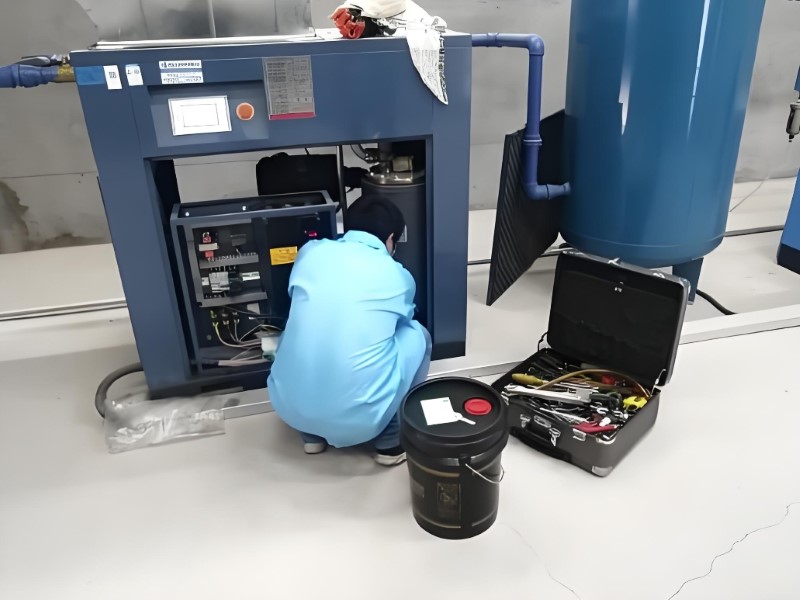
Tel :+ 86 13927313502
E-mail : 18902622229@163.com
Air Compressor Troubleshooting: How to Identify and Resolve Pressure Problems
Air compressors are indispensable tools in various industries, providing the necessary power for pneumatic tools, painting, inflating tires, and much more. However, like any mechanical equipment, they can encounter issues, especially concerning pressure problems. Understanding how to troubleshoot these issues is vital to maintaining efficiency and prolonging the life of your compressor. In this guide, we’ll explore common pressure problems, their causes, and effective solutions, ensuring your air compressor operates at peak performance.

1. Understanding Pressure Problems
Pressure problems in air compressors can manifest in several ways, such as insufficient pressure, fluctuating pressure, or pressure loss during operation. Recognizing these symptoms early can help prevent costly repairs and downtime.
Common Symptoms:
Inadequate Air Pressure: Tools may not operate effectively or may fail to start.
Pressure Fluctuations: Unstable air pressure can lead to inconsistent tool performance.
Continuous Running: The compressor may run longer than usual without reaching the desired pressure.
Identifying the root cause of these symptoms is crucial to implementing the right solutions.
2. Inspecting the Pressure Switch
The pressure switch is a critical component that regulates the compressor's operation by turning it on and off based on the desired pressure levels. If your air compressor is experiencing pressure problems, the first step is to check the pressure switch.
Key Features to Check:
Settings and Calibration: Ensure the pressure switch is set to the correct cut-in and cut-out pressures. Adjust if necessary.
Mechanical Integrity: Inspect for any visible damage or corrosion. A malfunctioning pressure switch can lead to erratic pressure readings.
Electrical Connections: Loose or corroded connections can disrupt the switch's operation. Ensure all wiring is secure and clean.
By ensuring the pressure switch functions correctly, you can often resolve pressure issues effectively.
3. Examining the Air Filter
A clogged air filter can significantly impact your air compressor's performance, causing pressure drops and reducing airflow. Regular maintenance of the air filter is essential for optimal operation.
Maintenance Tips:
Regular Cleaning or Replacement: Clean foam or oil-bath filters periodically and replace paper filters as per the manufacturer’s recommendations.
Visual Inspection: Look for dirt, dust, or blockages. A clean filter allows for smooth airflow, preventing pressure loss.
Airflow Checks: Conduct airflow tests to ensure adequate intake. If airflow is restricted, pressure problems will likely follow.
Keeping the air filter clean enhances the compressor’s efficiency, ensuring consistent air pressure.
4. Checking for Leaks
Air leaks can lead to significant pressure drops, often going unnoticed until performance issues arise. Identifying and sealing leaks is crucial to maintaining optimal pressure levels.
Leak Detection Methods:
Soapy Water Test: Apply a mixture of soap and water to connections, fittings, and hoses. Bubbles indicate escaping air.
Auditory Inspection: Listen for hissing sounds, which can signal a leak in the system.
Visual Inspection: Check all fittings and hoses for signs of wear, damage, or loose connections.
Addressing any identified leaks promptly can save energy and ensure your compressor maintains adequate pressure.
5. Inspecting the Tank and Drain Valve
The air tank stores compressed air, and any issues here can directly impact pressure. Additionally, the drain valve should be regularly checked to prevent water accumulation, which can affect performance.
Key Features to Inspect:
Tank Integrity: Look for signs of rust or corrosion. Damage to the tank can lead to pressure loss or safety hazards.
Drain Valve Functionality: Ensure the drain valve operates correctly to release moisture. Moisture buildup can lead to rust and affect pressure retention.
Regular Drainage: Always drain the tank after use to prevent moisture buildup. A clean, dry tank is essential for efficient compressor operation.
By maintaining the tank and drain valve, you help ensure that the compressor functions smoothly and retains proper pressure.
6. Evaluating the Regulator
The pressure regulator controls the pressure delivered to your tools. If the regulator malfunctions, it can lead to inconsistent pressure or pressure loss during operation.
Key Features to Check:
Setting Calibration: Ensure the regulator is set to the desired output pressure. Adjust if necessary.
Visual Inspection: Look for signs of damage or wear. A damaged regulator may not maintain consistent pressure.
Testing Output Pressure: Use a pressure gauge to check the output pressure. If it doesn’t match the setting, the regulator may need replacement.
A properly functioning regulator ensures that your tools receive the right amount of air pressure, enhancing their performance.
7. Routine Maintenance Practices
Preventive maintenance is key to avoiding pressure problems in your air compressor. Regular checks and servicing can prolong the life of your equipment and prevent unexpected breakdowns.
Maintenance Recommendations:
Regular Inspections: Conduct routine checks of all components, including belts, hoses, and electrical connections.
Scheduled Maintenance: Follow the manufacturer’s maintenance schedule for oil changes, filter replacements, and overall servicing.
Keep It Clean: Ensure the compressor is free from dust and debris to promote airflow and efficiency.
By committing to a regular maintenance routine, you can identify potential issues before they escalate, ensuring your air compressor remains in top condition.
Conclusion
Troubleshooting pressure problems in air compressors is essential for maintaining optimal performance and extending the life of your equipment. By understanding the key components that affect pressure—such as the pressure switch, air filter, and regulator—you can effectively diagnose and resolve issues before they become significant problems.
Remember, regular maintenance is your best ally in preventing pressure problems. By keeping your air compressor clean, inspecting for leaks, and ensuring all components function correctly, you can enjoy consistent and reliable performance. Whether you use your air compressor for professional tasks or home projects, being proactive in troubleshooting and maintenance will save you time and money in the long run.






